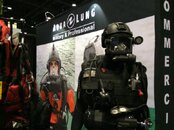It should be noted that the Rapid Diver is more at home in the trunk of a patrol car, on a Fire Truck or in a Helicopter then in a Dive Team trailer. The Rapid Diver was created in response to public safety and military needs for a universal fit, compact, versatile and easily deployed scuba system. The Public Safety Diving professionals that asked for a lighter, quicker and easier system did so because they were missing potential rescues by not having any equipment t assist in a water rescue at the scene.
Originally Posted by Jesquittieri
Rapid Diver = rescue diving Vs search and recovery.
I am with a Fire Department in SW Florida that covers one of the most complex water environments anywhere. My area of responsibility has hundreds of retention ponds, golf course ponds, naturally occurring lakes/ponds, and hundreds of miles of canals along the infamous Alligator Alley. The quick response of the Rapid Diver has been very successful.
Real life rescue scenarios;
1-Canal along I-75 and
The canals that run on both sides of I-75 has a perimeter of chain link fencing, some areas have the addition of barbed wire. There is a steep 10-15 foot embankment depending on the level of the canal. Zero visibility, weeds, grasses and rocks, not to mention the wildlife (alligators) has made successful rescues in the past nearly impossible. That was until we went to deployed Rapid Diver on our rescue trucks. No more heavy equipment or awkward uneven/unbalanced walking that led to premature fatigue. With all of the above mentioned obstacles quick deployable, lightweight gear is most advantageous factor to mitigate the call.
2-Neighboring Fire Depts. still uses the standard 80 cu ft aluminum for rescues.
Because of the large stretch of water that my department, our neighboring dept. which still use the traditional setup, sometimes respond to the same dive calls.
Both departments regularly arrive on scene at the same time. I can tell you, we beat them in the water 100% of the time. We have our divers fully packed out either waiting for further information or in the water performing rescue, while they are still getting geared up.
Rapid Diver = rescue diving not search and recovery.
3-Training Scenarios
My fire department regularly performs training that focus on real life rescue diving. Our last exercise involved dealing with zero visibility entanglement using nets and other hazards. Rescue divers wearing the Rapid Diver were out of the water in half the time of the back mounted divers. The beauty of the Rapid Diver is in its configuration. The tank is ideally situated in the front where the diver can easily protect, disentangle if necessary and manage
Originally Posted by Jesquittieri
Rapid Diver = rescue diving Vs search and recovery.
I am with a Fire Department in SW Florida that covers one of the most complex water environments anywhere. My area of responsibility has hundreds of retention ponds, golf course ponds, naturally occurring lakes/ponds, and hundreds of miles of canals along the infamous Alligator Alley. The quick response of the Rapid Diver has been very successful.
Real life rescue scenarios;
1-Canal along I-75 and
The canals that run on both sides of I-75 has a perimeter of chain link fencing, some areas have the addition of barbed wire. There is a steep 10-15 foot embankment depending on the level of the canal. Zero visibility, weeds, grasses and rocks, not to mention the wildlife (alligators) has made successful rescues in the past nearly impossible. That was until we went to deployed Rapid Diver on our rescue trucks. No more heavy equipment or awkward uneven/unbalanced walking that led to premature fatigue. With all of the above mentioned obstacles quick deployable, lightweight gear is most advantageous factor to mitigate the call.
2-Neighboring Fire Depts. still uses the standard 80 cu ft aluminum for rescues.
Because of the large stretch of water that my department, our neighboring dept. which still use the traditional setup, sometimes respond to the same dive calls.
Both departments regularly arrive on scene at the same time. I can tell you, we beat them in the water 100% of the time. We have our divers fully packed out either waiting for further information or in the water performing rescue, while they are still getting geared up.
Rapid Diver = rescue diving not search and recovery.
3-Training Scenarios
My fire department regularly performs training that focus on real life rescue diving. Our last exercise involved dealing with zero visibility entanglement using nets and other hazards. Rescue divers wearing the Rapid Diver were out of the water in half the time of the back mounted divers. The beauty of the Rapid Diver is in its configuration. The tank is ideally situated in the front where the diver can easily protect, disentangle if necessary and manage





